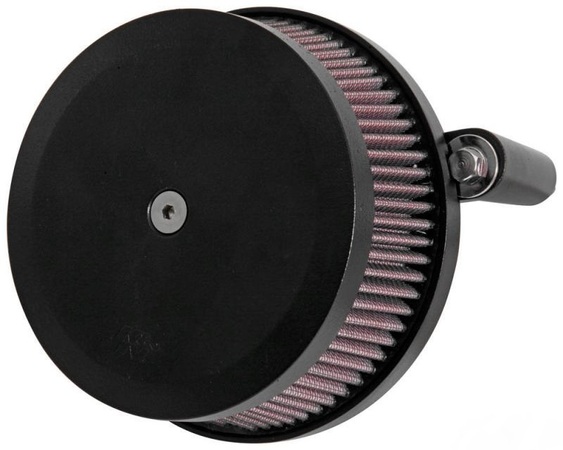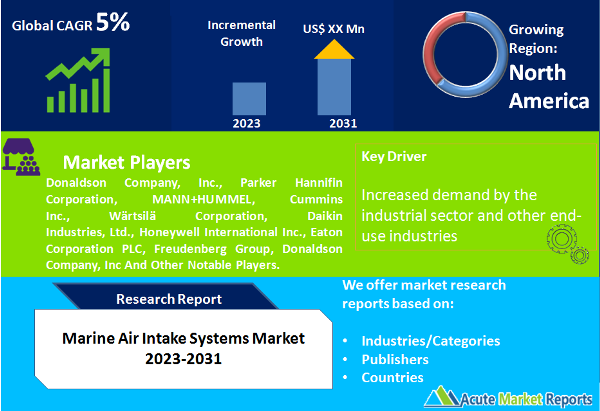
The marine air intake systems market refers to the market for air intake systems installed in marine vessels, such as ships and boats, to supply clean and filtered air for the efficient operation of engines and machinery on board. The marine air intake systems market is expected to grow at a CAGR of 5% during the forecast period of 2024 to 2032. This market plays a crucial role in ensuring optimal performance, reducing maintenance costs, and complying with environmental regulations. One of the key drivers of the marine air intake systems market is the increasing demand for fuel efficiency and emission control in the marine industry. Stringent regulations on emissions, particularly from marine vessels, have compelled shipbuilders and operators to adopt advanced air intake systems that minimize the intake of contaminants, enhance combustion efficiency, and reduce emissions. The International Maritime Organization's (IMO) regulations, such as MARPOL Annex VI, set limits on air pollution from ships and mandate the use of efficient air intake systems to meet emission standards. This has led to the widespread adoption of marine air intake systems in both new builds and retrofit applications. Another driver of the market is the growing trend of ship electrification and hybrid propulsion systems. As the marine industry strives for greener and more sustainable operations, there is a shift towards electric and hybrid propulsion technologies. These systems require optimized air intake solutions to ensure proper cooling and ventilation for the electrical components and batteries on board. Marine air intake systems play a crucial role in maintaining the operational efficiency and reliability of these advanced propulsion systems, thereby driving the demand in the market.

Increasing Environmental Regulations and Emission Standards
The marine industry is facing stringent environmental regulations and emission standards aimed at reducing air pollution from ships and vessels. These regulations, such as the International Maritime Organization's (IMO) MARPOL Annex VI, impose limits on sulfur oxide (SOx) and nitrogen oxide (NOx) emissions. As a result, shipbuilders and operators are compelled to adopt marine air intake systems that help minimize the intake of contaminants and improve combustion efficiency, thereby reducing emissions. For instance, ship engine manufacturers are incorporating advanced air filtration technologies and selective catalytic reduction (SCR) systems within marine air intake systems to meet these stringent emission standards.
Growing Demand for Fuel Efficiency and Operational Performance
Fuel efficiency is a critical concern for the marine industry due to rising fuel costs and environmental concerns. Marine air intake systems play a significant role in achieving optimal fuel efficiency by ensuring efficient combustion and reducing the energy required for engine operation. These systems provide clean and filtered air to the engines, minimizing the risk of contaminants that can affect combustion efficiency. Improved combustion efficiency translates into reduced fuel consumption and lower operational costs for vessel owners. The demand for marine air intake systems is driven by the need for enhanced operational performance and fuel efficiency, as evidenced by the increasing adoption of advanced air intake technologies in modern marine vessels.
Rising Focus on Safety and Preventive Maintenance
Safety and preventive maintenance are paramount in the marine industry to avoid costly breakdowns, engine failures, and operational disruptions. Marine air intake systems with effective filtration and separation technologies play a crucial role in protecting engines and machinery from premature wear, corrosion, and damage caused by harmful contaminants. Unfiltered air can contain particles, dust, debris, and saltwater mist, which can lead to engine failures and reduced performance. Shipbuilders and operators are increasingly recognizing the importance of reliable air intake systems in maintaining operational safety and reliability. This driver is supported by the industry's focus on preventive maintenance practices and the implementation of robust air filtration systems within marine air intake systems to ensure the longevity and reliability of marine vessels.
Limited Awareness and Adoption of Advanced Technologies
One of the significant restraints in the marine air intake systems market is the limited awareness and adoption of advanced technologies among shipbuilders and operators. While the industry is increasingly focused on environmental sustainability and operational efficiency, there exists a lack of awareness about the benefits and availability of advanced air intake systems. Many traditional vessels continue to use conventional air intake systems without incorporating modern filtration and separation technologies. The limited adoption of advanced technologies can be attributed to factors such as resistance to change, concerns regarding the initial investment cost, and the lack of understanding about the long-term benefits. Without the adoption of advanced air intake systems, vessels may face challenges in complying with stringent emission regulations, achieving optimal fuel efficiency, and ensuring engine reliability. While some industry players are actively embracing advanced technologies, there is a need for widespread education and awareness campaigns to highlight the advantages of modern marine air intake systems and overcome the barriers to their adoption. This restraint is supported by observations in the marine industry where traditional vessels continue to operate with conventional air intake systems. Despite the benefits offered by advanced air intake technologies, such as improved filtration, enhanced combustion efficiency, and reduced emissions, the uptake of these systems has been relatively slow. This can be attributed to the prevailing preference for familiar and established practices, as well as the perceived challenges associated with the initial investment and implementation of advanced technologies.
The Three-Stage Air Intake Systems Dominated the Market by Type
The marine air intake systems market can be segmented based on the type of air intake stages: single-stage, two-stage, and three-stage systems. Among these segments, the three-stage air intake systems are expected to exhibit the highest CAGR during the forecast period of 2024 to 2032 and also generated the highest revenue in 2023. Three-stage air intake systems offer advanced filtration and separation capabilities, making them more effective in removing contaminants from the intake air. These systems typically consist of multiple filters and separators that work together to remove particles, moisture, and other impurities before the air reaches the engine. The three-stage configuration ensures a higher level of filtration, providing cleaner air for combustion and reducing the risk of engine damage. The increasing demand for higher performance and improved engine reliability in the marine industry is driving the adoption of three-stage air intake systems. These systems offer enhanced protection against abrasive particles, saltwater mist, and other harmful contaminants that can cause premature wear and corrosion. As a result, the engines can operate more efficiently, with reduced maintenance requirements and extended service life. Furthermore, the rising environmental regulations and emission standards imposed on the marine industry are also contributing to the growth of three-stage air intake systems. These systems help vessels meet stringent emission limits by providing cleaner air for combustion, resulting in reduced exhaust emissions.
Combustion/Propulsion Engine Application Dominates the Application Segment
The marine air intake systems market can be segmented based on its application in combustion/propulsion engines and auxiliary/stationary power systems. Among these segments, the combustion/propulsion engine application is expected to exhibit the highest CAGR during the forecast period of 2024 to 2032 and generated the highest revenue in the market in 2023. The combustion/propulsion engine application segment represents the primary use of air intake systems in marine vessels, including ships, boats, and offshore platforms. These systems play a critical role in supplying clean and filtered air to combustion engines for efficient combustion and power generation. Clean air intake is essential for optimal engine performance, fuel efficiency, and reduced emissions. Therefore, the demand for air intake systems in combustion/propulsion engines is driven by the need for enhanced operational efficiency and compliance with environmental regulations. Additionally, the increasing focus on reducing emissions from marine vessels is further propelling the growth of the combustion/propulsion engine application segment. Stringent emission standards, such as those set by the International Maritime Organization (IMO), require vessels to minimize their environmental footprint by controlling exhaust emissions. Air intake systems equipped with advanced filtration technologies ensure that only clean air enters the engines, resulting in reduced emissions of pollutants such as sulfur oxides (SOx) and nitrogen oxides (NOx).
North America Leads by Revenues and APAC to Lead the Growth During the Forecast Period
North America held a significant share in terms of revenue in 2023 and is expected to continue its dominance in the forecast period of 2024 to 2032. The region is witnessing a growing demand for marine air intake systems due to the presence of a well-established marine industry, strict environmental regulations, and a focus on sustainable shipping practices. The United States, in particular, is a key market in North America, driven by the robust growth of the maritime sector and the increasing adoption of advanced air intake systems to meet emission standards. In terms of the region with the highest CAGR during the forecast period, Asia Pacific is expected to experience the fastest growth rate due to the region's expanding marine industry, stringent emission regulations, and the growing focus on sustainable shipping practices. The region's expanding maritime trade, rising investments in shipbuilding activities, and the emergence of economies such as China, South Korea, and Japan contribute to the growth of the market. Moreover, stringent environmental regulations and the need for fuel-efficient and eco-friendly vessels drive the demand for advanced air intake systems in the region.
Market to Remain Fragmented During the Forecast Period
The marine air intake systems market is highly competitive and fragmented, with several key players striving to gain a significant market share. These companies focus on implementing various strategies to strengthen their position and meet evolving customer demands. These companies emphasize product development and innovation as key strategies to gain a competitive edge. They invest in research and development activities to introduce advanced air intake systems with enhanced filtration capabilities, improved efficiency, and compliance with stringent emission regulations. By offering technologically advanced solutions, these companies aim to cater to the evolving needs of the marine industry. Furthermore, strategic partnerships, collaborations, and acquisitions play a vital role in the competitive landscape of the marine air intake systems market. Key players forge partnerships with other industry participants, including shipbuilders, engine manufacturers, and component suppliers, to expand their customer base and enhance their market presence. In the marine air intake systems market, prominent players include Donaldson Company, Inc., Parker Hannifin Corporation, MANN+HUMMEL, Cummins Inc., Wartsila Corporation, Daikin Industries, Ltd., Honeywell International Inc., Eaton Corporation PLC, Freudenberg Group, Donaldson Company, Inc. and others.
Historical & Forecast Period
This study report represents analysis of each segment from 2022 to 2032 considering 2023 as the base year. Compounded Annual Growth Rate (CAGR) for each of the respective segments estimated for the forecast period of 2024 to 2032.
The current report comprises of quantitative market estimations for each micro market for every geographical region and qualitative market analysis such as micro and macro environment analysis, market trends, competitive intelligence, segment analysis, porters five force model, top winning strategies, top investment markets, emerging trends and technological analysis, case studies, strategic conclusions and recommendations and other key market insights.
Research Methodology
The complete research study was conducted in three phases, namely: secondary research, primary research, and expert panel review. key data point that enables the estimation of Marine Air Intake Systems market are as follows:
Market forecast was performed through proprietary software that analyzes various qualitative and quantitative factors. Growth rate and CAGR were estimated through intensive secondary and primary research. Data triangulation across various data points provides accuracy across various analyzed market segments in the report. Application of both top down and bottom-up approach for validation of market estimation assures logical, methodical and mathematical consistency of the quantitative data.
| ATTRIBUTE | DETAILS |
|---|---|
| Research Period | 2022-2032 |
| Base Year | 2023 |
| Forecast Period | 2024-2032 |
| Historical Year | 2022 |
| Unit | USD Million |
| Segmentation | |
Type
| |
Component
| |
Application
| |
Vessel
| |
|
Region Segment (2022-2032; US$ Million)
|
Key questions answered in this report